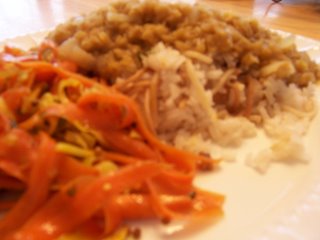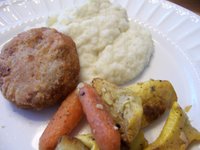
Christ is Risen!
This year at my church, I baked the Artos for Pascha since the lady who usually performs this service was not able to do it. Its been a long time since I've baked Artoklasia or even Qurban (aka prosphora), and I really enjoyed doing it. I've been at my current current parish for about 8 1/2 years, and its been that long since I've baked the qurban (the prosphora - the bread used for communion) and I've only baked the Artoklasia a few times in the very distant past - back in my COR days. I've never baked the Artos before, so I was a tad nervous about it, but excited and honored as well.
A word about the difference between the three breads:
Prosphora has several names according to the liturgical language you are using, and is the bread used for Holy Communion. It is made from only pure white flour, water, yeast and salt - no other ingredients are allowed. It is made in either one large loaf with a seal depicting ICXC and NIKA imprinted on it, or five small double loaves with a small seal on it.
Artoklasia is five loaves of spiced and sweetened bread, without a seal, which are blessed during the portion of Vigil called the Litya. It is sometimes erroneously called the Litya bread here in America. Artoklasia commemorates Christ's miracle of feeding the many when he blessed the five loaves and two fish and fed over 5000 people. These sweet loaves are brought to church as an expression of gratitude for God's bountiful blessings.
Artos actually means "bread", so to say Artos bread actually means bread bread and is made only for Pascha. It is very similar to Artoklasia, and can be made from the same recipe, but is always made in one large loaf which has been decorated with grapes, wheat or olives, or with the traditional seal depicting the Risen Savior (which I don't have). Artos is blessed at the end of the midnight Paschal liturgy, and remains in the church until it is broken and distributed to the faithful one week later, on Thomas Sunday.
Paschal Artos4 tsp or 2 packets of dried yeast
approximately 6 C of unbleached white flour
3/4 C white sugar
1/4 C brown sugar
1 tsp salt
1 tsp ground cinnamon
1/4 tsp ground cloves
1/2 tsp ground allspice
1/2 tsp ground nutmeg
freshly grated zest of one orange
Mix all the above listed dry ingredients together to make sure everything is well distributed. Then, mix together the wet ingredients in a separate measuring cup.
Freshly squeezed juice of one orange plus warm water to make at least 1/4 C
1/4 C vegetable oil
1 1/2 tsp natural vanilla extract (do not use imitation vanilla flavoring!)
1 1/4 C water hot from the tap
Make a well in the flour and begin pouring in the liquid ingredients, beating with a spoon as you are doing so. Keep it up, changing to kneading with your hands, until all the liquid ingredients are incorporated into the dough. If the dough is very sticky, add more flour by the tablespoon until the dough is not sticky any more, and is stiffish but not overly dry. Cover and let rise in a warm place until doubled, about an hour. Punch down, cover and allow to rise until doubled again, about another hour. Preheat oven to 350F.
To make
Artoklasia, divide the dough into five portions and form into round balls. Let rise 20 minutes, then bake 20 - 25 minutes. Alternatively, roll the dough out to half an inch thickness, let rest till the gluten relaxes a bit, about 5 minutes, then using a 3" or 4" cookie cutter or a teacup, cut out rounds which can be decorated with a cross. Cover and allow to rise 20 minutes, then bake for 10 - 15 minutes until golden brown and cooked through.
To make
Artos, pinch off one smallish handful of dough and set aside to make decorations. Form the rest of the dough into a round loaf. Then make your decorations and apply to the loaf by moistening them with water so that they will stick to the dough. Grapes, wheat and olive branches are traditional. Once the 3-dimensional decorations have been applied, brush the surface of all the decorations and the loaf with an egg wash. After about 10 minutes in the oven, check to see that the egg wash is not browning too much and tent the loaf with foil to cut down on browning more while it continues baking. Bake for 30 - 40 minutes until the loaf is golden brown and sounds hollow when tapped.
If you have the special Artos seal, then you would not make other decorations. You would impress the seal in the center of the formed round loaf, and would not use the egg wash.
Indeed He is Risen!
++++++++++++++++++++++++++=
Update on Monday, May 1, 2006:
This Artos was blessed and broken yesterday at church. The verdict was that it was absolutely delicious - pretty much everyone told me that it was the best Artos they've ever eaten and that they love the orange flavor. So, this recipe is winner, for sure.
What would I do differently next time?
Well, our Deacon told me that there was a small ball of uncooked dough in the center of the loaf. I think that happened because it got very brown VERY fast, and I took it out before it was cooked. Next time, I would lower the heat 25 degrees, tent it with foil after the first five or ten minutes, and cook it about 15 minutes longer.
I also think the flavor would be improved doubling the spices and adding just a little bit of minced candied citron. I'm not a big lover of citron, and if I had some home-made candied orange peel, I'd use that. I think just a little bit, maybe 1/4 cup, would be enough. I'd pinch off the dough for the decorations first, then I'd knead the fruit into the bread.
I would also decorate it much more heavily - I put one bunch of grapes with a few on the side -- I'd probably make three large bunches of grapes and bunch of curly stems and leaves. Or, maybe I'd order the seal from
www.prosfora.org if I knew earlier that I'd be making it.
But I doubt I'll be making it next year, and a young woman in my parish makes all the Artoklasia used at Litya in our parish, so who knows when I'll make this again? It was really delish, though.











